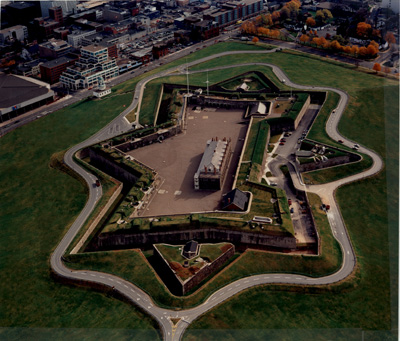Halifax Citadel National Historic Site of Canada
Halifax, Nova Scotia

Aerial view
(© Parks Canada Agency / Agence Parcs Canada)
Address :
5425 Sackville Street, Halifax, Nova Scotia
Recognition Statute:
Historic Sites and Monuments Act (R.S.C., 1985, c. H-4)
Designation Date:
1935-05-29
Dates:
-
1828 to 1856
(Construction)
-
1749 to 1906
(Significant)
Event, Person, Organization:
-
British Army
(Organization)
-
British Empire
(Organization)
Other Name(s):
-
Halifax Citadel
(Designation Name)
Research Report Number:
1965-03; 1964-13
DFRP Number:
02991 00
Plaque(s)
Existing plaque: 5425 Sackville Street, Halifax
Built to defend against a land-based attack, the Halifax Citadel was the fourth in a series of forts to occupy this hill. The star-shaped fortress, completed in 1856, was the centrepiece of the extensive system of fortifications constructed by the British military from 1749 to protect this strategic port, which by the mid-19th century had become one of four principal naval stations in the British Empire. Garrisoned by the British until the Canadian military assumed control of all Halifax defences in 1906, the Citadel stands today as a reminder of our rich colonial and military past.
*Note: This designation has been identified for review. A review can be triggered for one of the following reasons - outdated language or terminology, absence of a significant layer of history, factual errors, controversial beliefs and behaviour, or significant new knowledge.
Description of Historic Place
Halifax Citadel is a large, stone early 19th-century British fortification located atop Citadel Hill, in Halifax, Nova Scotia. The walled citadel is surrounded by an expansive grassed glacis descending to the commons on the west side and downtown Halifax on the east side. It is the most prominent fortification in a network of defensive works that have historically guarded Halifax, its dockyard and its harbour.
Heritage Value
Halifax Citadel was designated a national historic site because of: its role in the development of Halifax as one of the four principal naval stations of the British Empire during the 18th and 19th centuries, and because it is an important element in the uniquely complete conspectus of shore defences that developed at Halifax between the 18th century and World War II, to defend British and, after 1906, Canadian interests.
The heritage value of Halifax Citadel National Historic Site lies in its commanding location, in the legibility of its found cultural landscape as a substantial 19th-century fortification, and in the integrity of surviving 18th, 19th, and 20th-century remnants of that landscape. These include all historic resources linked to the landward defence of the town and to the harbour defences along the water that protected the naval station.
Although Halifax Citadel was established as a British post in 1749, the present fort dates from the 1828-1856 period and is its fourth generation of defence works. The Citadel was occupied by British forces until 1906, then by the Canadian military as a detention camp during World War I, and as Halifax headquarters for anti-aircraft defences during World War II. It became a national historic site in 1956 and has since been restored for public visitation.
Sources: HSMBC, Minutes, 1965; Commemorative Integrity Statement.
Character-Defining Elements
Key features contributing to the heritage value of this site include:
the evolved cultural landscape comprising its star-shaped footprint, the profile of its built features, its open ground, and remnants of 18th-20th-century military activity including the glacis, the footprint of Fort George, extant historic buildings, structures, site roads, remains and landscape features, siting on a drumlin centrally located on the peninsula adjacent to Halifax harbour, the open ground that surrounds it (the lack of trees on the glacis), the 1930s perimeter roadway connecting the Citadel to the town, and roadways, pathways, channels and tunnels providing internal communications, viewplanes to the inner harbour, to landward approaches, to other harbour defences, to the town blocks adjacent to the harbour and those historically linked to the Citadel such as Royal Artillery Park, the Commons, and the Public Garden.
The fort: the bastion design with star-shaped footprint and profile, functional design, found form, materials and spatial relationships of elements including the parade, south-east and north-east salients, the redan, the south-west and north-west demi-bastions and the west front, fort walls, casemates, counter-mine tunnels and musket gallery, the ditch, ravelins and glacis, south magazine, and north magazine (canteen building).
Defensive works outside the fort: the siting, mass, design and spatial relationships of extant military resources on the hill including casemates, north and south magazines, two expense magazines on the ramparts, the Cavelier building, the found materials of their construction (primarily stone with supplementary brick as structural support in such areas as casemate arches).
Archaeological remains the footprints, materials and spatial relationships of early military facilities including gun emplacements on the ramparts (for smooth bores and RMLs), a barracks foundation, cisterns with a drainage system beneath the parade, a tunnel under the glacis' west side.